Table of Contents
The Rectangular to Polar Calculator is a free online tool that converts rectangular coordinates to polar coordinates. STUDYQUERIES’s online rectangular to polar calculator tool performs the calculation faster, and it displays the conversion in a matter of seconds.
How to Use the Rectangular to Polar Calculator?
Using a rectangular calculator to convert to a polar calculator is as follows:
- Step 1: Enter the x and y coordinates in the respective input fields
- Step 2: To calculate polar coordinates, click the “Calculate Polar Coordinates” button
- Step 3: The polar coordinates will be displayed in the output field
Rectangular To Polar Calculator
What is Meant by the Rectangular to Polar Coordinates?
A rectangular coordinate is a pair of coordinates that are measured along axes that are at right angles to each other. Polar coordinates are a pair of coordinates that define the position in the plane where the first coordinate defines the length of the straight line that connects the points to the origin and the second coordinate is the angle formed by this line and the fixed-line.
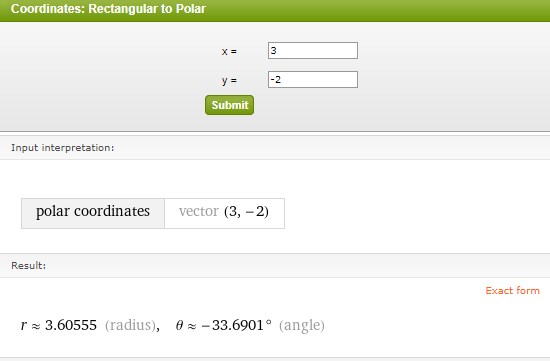
Plotting Points Using Polar Coordinates
When we think about plotting points in the plane, we usually think of rectangular coordinates \((x,y)\) in the Cartesian coordinate plane. However, there are other ways to write a coordinate pair and other types of grid systems. In this section, we introduce polar coordinates, which are points labeled \((r,\theta)\) and plotted on a polar grid. Radiating outward from a pole, or the origin of the coordinate plane, the polar grid is represented as a series of concentric circles.
The polar grid is scaled as the unit circle with the positive x-axis now viewed as the polar axis and the origin as the pole. The first coordinate \(r\) is the radius or length of the directed line segment from the pole. The angle \(\theta\), measured in radians, indicates the direction of \(r\).
We move counterclockwise from the polar axis by an angle of \(\theta\) and measure a directed line segment the length of \(r\) in the direction of \(\theta\). Even though we measure \(\theta\) first and then \(r\), the polar point is written with the \(r\ -coordinate\) first. For example, to plot the point \((2,\frac{\pi}{4})\), we would move \(\frac{\pi}{4}\) units in the counterclockwise direction and then a length of \(2\) from the pole.
\(\pmb{\color{red}{Plot\ the\ point\ (3,\frac{\pi}{2})\ on\ the\ polar\ grid.}}\)
The angle \(\frac{\pi}{2}\) is found by sweeping in a counterclockwise direction \(90°\) from the polar axis. The point is located at a length of \(3\ units\) from the pole in the \(\frac{\pi}{2}\) direction.
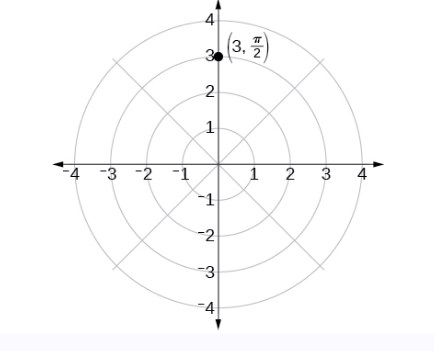
Converting from Polar Coordinates to Rectangular Coordinates
When given a set of polar coordinates, we may need to convert them to rectangular coordinates. To do so, we can recall the relationships that exist among the variables \(x, y, r, and\ θ.\)
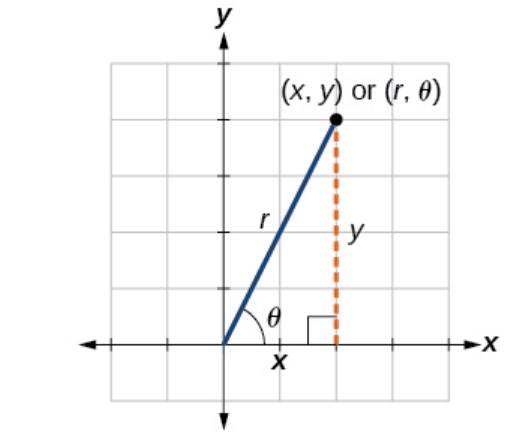
$$\cos{\theta}=\frac{x}{r}\longrightarrow{x}=r\cos{\theta}$$
$$\sin{\theta}=\frac{y}{r}\longrightarrow{y}=r\cos{\theta}$$
Dropping a perpendicular from the point in the plane to the \(x-axis\) forms a right triangle, as illustrated in Figure. An easy way to remember the equations above is to think of \(\cos{\theta}\) as the adjacent side over the hypotenuse and \(\cos{\theta}\) as the opposite side over the hypotenuse.
Given the polar coordinate \((r,\theta)\), write {x}=\(r\cos{\theta}\) and \({y}=r\sin{\theta}.\)
Evaluate \(\cos{\theta}\) and \(\sin{\theta}\) .
Multiply \(\cos{\theta}\) by \(r\) to find the \(x\ -coordinate\) of the rectangular form.
Multiply \(\sin{\theta}\) by \(r\) to find the \(y\ -coordinate\) of the rectangular form.
\(\pmb{\color{red}{Write\ the\ polar\ coordinates\ (3,\frac{\pi}{2})\ as\ rectangular\ coordinates.}}\)
Use the equivalent relationships.
$$x=r\cos{\theta}$$
$$=3\cos{\frac{\pi}{2}}$$
$$=3\times 0$$
$$\color{red}{x=0}$$
$$y=r\sin{\theta}$$
$$=3\sin{\frac{\pi}{2}}$$
$$=3\times 1$$
$$\color{red}{y=3}$$
So, The rectangular coordinates are \(\color{red}{(0,3)}\).
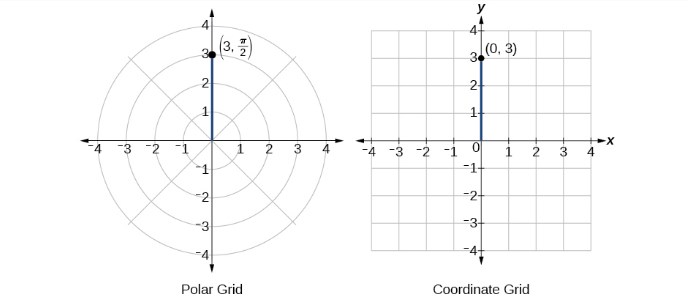
Converting from Rectangular Coordinates to Polar Coordinates
To convert rectangular coordinates to polar coordinates, we will use two other familiar relationships. With this conversion, however, we need to be aware that a set of rectangular coordinates will yield more than one polar point.
Converting from rectangular coordinates to polar coordinates requires the use of one or more of the relationships illustrated in Figure.
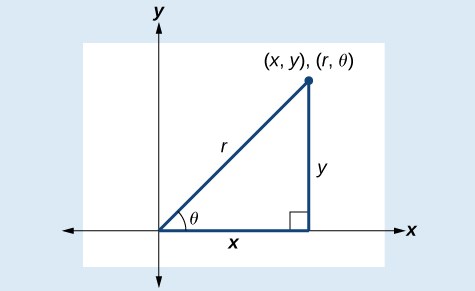
$$\cos{\theta}=\frac{x}{r}\ or\ x=r\cos{\theta}$$
$$\sin{\theta}=\frac{y}{r}\ or\ y=r\sin{\theta}$$
$$r^2=x^2+y^2$$
$$\tan{\theta}=\frac{y}{x}$$
\(\pmb{\color{red}{Convert\ the\ rectangular\ coordinates\ (3,3)\ to\ polar\ coordinates.}}\)
We see that the original point \((3,3)\) is in the first quadrant. To find \(\theta\) , use the formula \(\tan{\theta}=\frac{y}{x}\).
This gives
$$\tan{\theta}=\frac{3}{3}$$
$$\tan{\theta}=1$$
$$\color{red}{\tan^{-1}{(1)}=\frac{\pi}{4}}$$
To find \(r\), we substitute the values for \(x\) and \(y\) into the formula \(r=\sqrt{x^2+y^2}\). We know that \(r\) must be positive, as \(\frac{\pi}{4}\) is in the first quadrant. Thus
$$r=\sqrt{3^2+3^2}$$
$$r=\sqrt{9+9}$$
$$r=\sqrt{18}$$
$$\color{red}{r=3\sqrt{2}}$$
So, \(r=3\sqrt{2}\) and \(\theta=\frac{\pi}{4}\), giving us the polar point \((3\sqrt{2},\frac{\pi}{4})\).
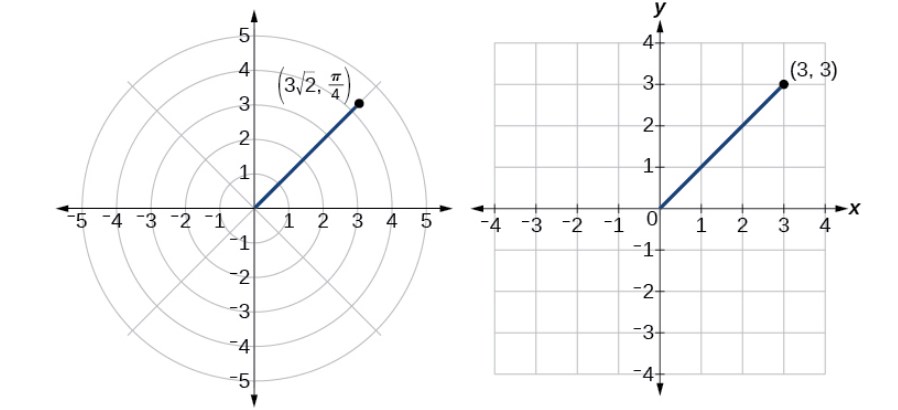
Important Points To Remember
- The polar grid is represented as a series of concentric circles radiating out from the pole, or origin.
- To plot a point in the form \((r,\theta), \theta \gt0\), move in a counterclockwise direction from the polar axis by an angle of \(\theta\) and then extend a directed line segment from the pole the length of \(r\) in the direction of \(\theta\). If \(\theta\) is negative, move in a clockwise direction, and extend a directed line segment the length of \(r\) in the direction of \(\theta\).
- If \(r\) is negative, extend the directed line segment in the opposite direction of \(\theta\).
- To convert from polar coordinates to rectangular coordinates, use the formulas \(x=r\cos{\theta}\) and \(y=r\sin{\theta}\).
- To convert from rectangular coordinates to polar coordinates, use one or more of the formulas: \(\cos{\theta}=\frac{x}{r}\), \(\sin{\theta}=\frac{y}{r}\), \(\tan{\theta}=\frac{y}{x}\), and \(r=\sqrt{x^2+y^2}.\)
- Transforming equations between polar and rectangular forms means making the appropriate substitutions based on the available formulas, together with algebraic manipulations.
- Using the appropriate substitutions makes it possible to rewrite a polar equation as a rectangular equation, and then graph it in the rectangular plane.
Polar to Rectangular Equation Calculator:
A polar to rectangular equation calculator helps in converting a polar equation into its equivalent rectangular equation. Polar equations are expressed in terms of angles (θ) and distances (r) from the origin. The calculator allows you to input the polar equation and performs the conversion, providing the corresponding rectangular equation.
Example: Given a polar equation r = 2sin(θ), the polar to rectangular equation conversion yields the rectangular equation y = 2x.
Polar Equation to Rectangular Equation Calculator:
A polar equation to rectangular equation calculator serves the same purpose as the previous calculator but with a different name. It allows you to input a polar equation and converts it into the equivalent rectangular equation.
Example: Consider the polar equation r = 3cos(θ). Converting this equation using the calculator would yield the rectangular equation x = 3.
Rectangular to Polar Coordinates Calculator:
A rectangular to polar coordinates calculator performs the conversion from rectangular coordinates (x, y) to polar coordinates (r, θ). Rectangular coordinates use the x-axis and y-axis to specify points on a plane, while polar coordinates use the distance from the origin (r) and the angle from the positive x-axis (θ).
Example: Given rectangular coordinates (2, 2), the calculator would convert them to polar coordinates (r, θ) ≈ (√8, 45°).
Polar to Rectangular Coordinates Calculator:
A polar to rectangular coordinates calculator converts polar coordinates (r, θ) to rectangular coordinates (x, y). It takes the distance from the origin (r) and the angle from the positive x-axis (θ) and calculates the corresponding rectangular coordinates.
Example: For polar coordinates (4, 60°), the calculator would convert them to rectangular coordinates (x, y) ≈ (2, 2√3).
Rectangular to Polar Calculator with Steps:
A rectangular to polar calculator with steps provides a detailed explanation of the conversion process from rectangular coordinates to polar coordinates. It breaks down the calculations and shows the intermediate steps to help understand the conversion.
Example: When using a rectangular to polar calculator with steps to convert rectangular coordinates (3, -4), it would provide the detailed calculation, such as calculating the distance from the origin (r) using the Pythagorean theorem: r = √(3^2 + (-4)^2) = 5.
Rectangular to Polar Calculator Complex:
A rectangular to polar calculator complex is specifically designed to handle complex numbers in rectangular form (a + bi) and convert them to polar form (r ∠ θ). It takes the real part (a) and the imaginary part (b) of the complex number and calculates the corresponding magnitude (r) and argument (θ) in polar form.
Example: Given the complex number -2 + 2i, the rectangular to polar calculator complex would convert it to polar form as 2√2 ∠ 135°.
Rectangular to Polar Equation:
A rectangular to polar equation represents the conversion of a rectangular equation to its equivalent polar equation. Rectangular equations are expressed in terms of x and y coordinates, while polar equations are expressed in terms of r and θ.
Example: The rectangular equation x^2 + y^2 = 1 can be converted to the polar equation r = 1.
FAQs
How do you convert rectangular form to polar form without a calculator?
Converting from Rectangular Coordinates to Polar Coordinates
\(\cos{\theta}=\frac{x}{r}\ or\ x=r\cos{\theta}\)
\(\sin{\theta}=\frac{y}{r}\ or\ y=r\sin{\theta}\)
\(\tan{\theta}=\frac{y}{x}.\)
How do you convert rectangular to Polar manually?
To convert from polar to rectangular, find the real component by multiplying the polar magnitude by the cosine of the angle, and the imaginary component by multiplying the polar magnitude by the sine of the angle.
How do you convert rectangular coordinates to cylindrical coordinates?
To convert a point from Cartesian coordinates to cylindrical coordinates, use equations \(r^2=x^2+y^2,\tan{\theta}=\frac{y}{x}\), and \(z=z\).
How do you convert rectangular form to polar form in Python?
rect() method converts polar coordinates to rectangular form of the complex number. It creates a complex number with phase and modulus. This method is equivalent to r * (math. cos(phi) + math.
What is rectangular and polar form?
Rectangular coordinates, or cartesian coordinates, come in the form \((x,y)\). Polar coordinates, on the other hand, come in the form \((r,\theta)\). Instead of moving out from the origin using horizontal and vertical lines, we instead pick the angle \(\theta\), which is the direction, and then move out from the origin a certain distance \(r\).
How to Convert Rectangular to Polar Without Calculator?
To convert rectangular coordinates (x, y) to polar coordinates (r, θ) without using a calculator, you can follow these steps:
– Calculate the distance from the origin using the formula: r = √(x^2 + y^2).
– Determine the angle θ using trigonometric functions. If x > 0, use θ = arctan(y/x). If x < 0, use θ = arctan(y/x) + π. If x = 0 and y > 0, use θ = π/2. If x = 0 and y < 0, use θ = -π/2. If x = 0 and y = 0, the point is at the origin.
How to Convert Rectangular to Polar Using Scientific Calculator?
To convert rectangular coordinates to polar coordinates using a scientific calculator, follow these steps:
– Enter the x-coordinate.
– Enter the y-coordinate.
– Use the trigonometric functions on the calculator to calculate the magnitude (r) and angle (θ) of the polar coordinates.
How to Convert Rectangular to Polar Using Scientific Calculator FX-991ES?
To convert rectangular coordinates to polar coordinates using the Casio scientific calculator FX-991ES, you can follow these steps:
– Press the MODE button, then select the complex mode.
– Enter the x-coordinate, press the “+/-” button for negative values.
– Press the “RCL” button followed by the “θ” button to display the polar form.
How to Convert Rectangular Form to Polar Form Using Casio Calculator?
To convert a complex number in rectangular form (a + bi) to polar form (r ∠ θ) using a Casio calculator, follow these steps:
– Press the MODE button, then select the complex mode.
– Enter the real part (a) followed by the “+” or “-” button.
– Enter the imaginary part (b), then press the “RCL” button followed by the “θ” button to display the polar form.
How to Convert Rectangular Coordinates to Polar Coordinates with a Graphing TI-84 Calculator?
To convert rectangular coordinates to polar coordinates using a TI-84 graphing calculator, you can follow these steps:
– Enter the x-coordinate.
– Enter the y-coordinate.
– Press the “2nd” button followed by the “APPS” button, then select “1: Transfrm.”
– Scroll down and select “6: polar(,),” then press the “Enter” button.
– The calculator will display the polar coordinates (r, θ) corresponding to the rectangular coordinates.
